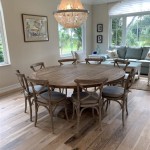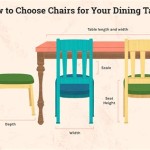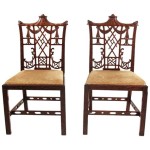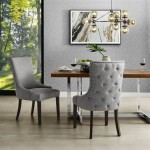Dining Room Sets For Small Areas: Maximizing Space Without Sacrificing Style
The challenge of furnishing a small dining area is a common one, particularly in apartments, condominiums, and smaller homes. Limited square footage necessitates careful consideration of furniture choices. A well-selected dining room set can transform a cramped space into a functional and aesthetically pleasing area for meals and gatherings. However, cramming a large, cumbersome set into a limited space can make the room feel claustrophobic and impractical. Therefore, understanding the principles of space-conscious design and the available options is crucial for optimizing a small dining area.
The goal in a small dining area is to maximize usable space while maintaining a comfortable and inviting atmosphere. This involves selecting furniture that is appropriately scaled, features clever storage solutions, and utilizes visual tricks to create the illusion of spaciousness. Size, shape, material, and style all contribute to the overall impact of a dining room set on a small space. A thoughtful approach to these elements can result in a dining area that is both functional and stylish, despite its limited dimensions.
Before selecting a dining room set, it is essential to accurately measure the available space. This will provide a clear understanding of the maximum dimensions that the furniture can occupy without obstructing movement or making the room feel overcrowded. Consider the placement of walkways, doorways, and other furniture pieces within the room. Allow sufficient space for chairs to be pulled out comfortably and for people to move around the table without bumping into walls or other objects. Once the available dimensions are known, the selection process can begin, focusing on sets that fit within those parameters.
When considering the specific dimensions of the dining set, remember to factor in the space needed for chairs to be pulled out and for people to sit comfortably. Aim for at least 36 inches of clearance between the edge of the table and any walls or obstructions. This will allow for easy movement and prevent the room from feeling cramped. If space is particularly tight, consider using chairs without arms, as they typically take up less room. Alternatively, benches can provide seating while taking up less visual space than individual chairs.
Choosing the Right Table Shape and Size
The shape of the dining table plays a significant role in optimizing space in a small dining area. Round tables are often preferred in smaller spaces because they eliminate sharp corners and allow for more flexible seating arrangements. A round table can comfortably accommodate a varying number of people without feeling crowded. Additionally, round tables tend to encourage conversation and create a more intimate dining experience. Square tables offer a similar benefit in terms of space efficiency, especially when placed against a wall or in a corner. However, they may not be as versatile as round tables in accommodating different numbers of guests.
Rectangular tables, while often preferred for larger dining rooms, can also work in smaller spaces if selected carefully. The key is to choose a rectangular table that is narrow and relatively short. This will prevent the table from dominating the room and obstructing movement. A rectangular table can be placed against a wall to save space when not in use, and can be pulled out when needed to accommodate more guests. Drop-leaf tables, which feature leaves that can be folded down to reduce the table's size, are an excellent option for small dining areas. These tables can be used in their compact form for everyday meals and expanded when guests are present.
The size of the table should be proportionate to the size of the room. Avoid choosing a table that is too large, as it will make the room feel cramped and uncomfortable. A general guideline is to allow at least 24 inches of space per person at the table. This will ensure that everyone has enough room to eat comfortably without feeling crowded. When selecting a table size, consider the number of people who will typically be dining at the table. If the dining area is primarily used by one or two people, a small table is sufficient. If the dining area is used for occasional gatherings, a larger table may be necessary, but consider a table with leaves to accommodate guests without taking up excessive space when not in use.
Selecting Space-Saving Seating Options
The choice of seating can significantly impact the overall space efficiency of a small dining area. Chairs with a slim profile are ideal, as they take up less visual space and allow for easier movement around the table. Chairs without arms are generally a better choice for small spaces, as they can be tucked under the table more easily, saving valuable floor space. Transparent chairs, made of materials such as acrylic or polycarbonate, are an excellent option for creating the illusion of spaciousness. These chairs allow light to pass through them, making the room feel more open and airy.
Benches offer another space-saving seating solution. They can be pushed against a wall when not in use, freeing up floor space. Benches can also provide hidden storage underneath, which is particularly useful in small apartments or homes where storage space is limited. When choosing a bench, consider one with a backrest for added comfort. Alternatively, a backless bench can be used in conjunction with decorative pillows to provide support and add a touch of style.
Folding chairs are a practical option for small dining areas that are only used occasionally. These chairs can be easily folded up and stored away when not needed, freeing up valuable floor space. Folding chairs are available in a variety of styles and materials, so it is possible to find options that complement the overall décor of the room. When selecting folding chairs, ensure that they are sturdy and comfortable to sit on. Look for chairs with padded seats and backrests for added comfort.
Utilizing Materials, Colors and Storage
The materials and colors used in a dining room set can significantly impact the perceived size of the space. Light-colored furniture and walls can make a small room feel brighter and more spacious. Light colors reflect light, which helps to create the illusion of openness. Dark colors, on the other hand, tend to absorb light, which can make a small room feel darker and more cramped. If dark colors are desired, use them sparingly as accents or in smaller furniture pieces.
Mirrored surfaces can also be used to create the illusion of space. A large mirror placed on a wall can reflect light and make the room feel larger. Consider placing a mirror behind the dining table to create a focal point and add depth to the room. Avoid placing mirrors in areas where they will reflect clutter, as this will detract from the overall aesthetic of the space.
Dining sets with integrated storage can be a great solution for small spaces. Tables with built-in drawers or shelves provide convenient storage for linens, cutlery, and other dining essentials. Consider a sideboard or buffet with ample storage space to keep the dining area organized and clutter-free. These pieces can also serve as a display area for decorative items, adding a touch of personality to the room.
Glass-topped tables are a popular choice for small dining areas, as they allow light to pass through and create a sense of openness. Glass tables also tend to be easy to clean and maintain. Consider pairing a glass-topped table with light-colored chairs to create a bright and airy dining space. Metal accents, such as chrome or stainless steel, can also help to create a modern and spacious feel. These materials reflect light and add a touch of sophistication to the room.
The key to furnishing a small dining area is to choose furniture that is functional, stylish, and appropriately scaled for the space. By considering the size, shape, material, and style of the dining room set, it is possible to create a dining area that is both comfortable and inviting, despite its limited dimensions. Careful planning and thoughtful selection will result in a space that maximizes functionality and enhances the overall aesthetic of the home. Ultimately, the goal is to create a dining area that is both practical and enjoyable, serving as a welcoming space for meals and gatherings.

Small Spaces Compact Dining Set Round Walnut Kitchen Table Wood 4 Chairs New 5pc Ebay

Costway Light Gray Wood 28 In 4 Legs Rectangular Kitchen Dining Table For Small Space Seats Th65554 A0gr The Home

5pieces Dining Set 35 Square Kitchen Table Faux Marble Top 4 Chairs Small Space Ebay

Small Dining Table Kitchen Pottery Barn

Homary Dining Set Round Table Solid Wood For 4

5 Piece Kitchen Dining Table And Chair Set Room With 4 Chairs Rectangle For Dinette

6 Piece Gray Family Dining Room Set Solid Wood Space Saving Foldable Table And 4 Chairs With Bench For

Space Saving Solid Wood Nesting Dining Table And Chairs Set Sps Furntiure

Incorporating A Dining Table Set Into Small Space Here S How Laura James

Small Round 5 Piece Dining Set 35 Pedestal Table With 4 Beige Rattan Boucle Chairs Double Layer Back Maison








